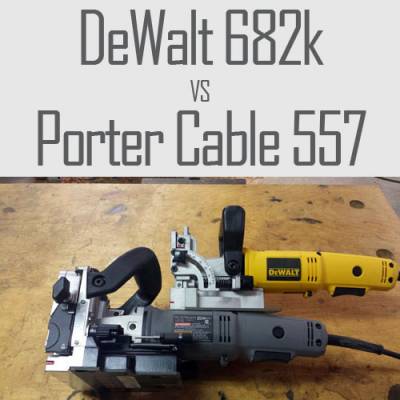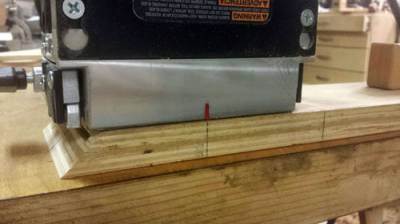Home - This Old Workshop
DeWalt 862k vs Porter Cable 557 Plate Joiner face off
Here I’ll review two of the most popular plate joiners on the market, the Porter Cable 557 and the DeWalt 682K. Before we even get into picking these tools apart, I’ll start by saying that both of these products are top notch and either of them will serve you well. The major differences are the placement of adjustment knobs and a few additional features found on the 557. These tools are both similarly sized, easy to use, and fully capable of handling whatever you throw there way.
Adjustments & Alignment:
Height adjustment on both of these tools is pretty straight forward, turn a dial, lock it down, and off you go! Like usual, the devil is in the details, though.
The 682K uses a dovetailed slide mechanism with a rack and pinion that adjusts the vertical placement of the cutter. The adjustment and locking knob are both on the right side of the fence, which is nice so you don't have to use both hands to make adjustments. This system works well and traverses the cutting range much faster than the 557. As a trade-off, the height adjustment doesn’t feel as smooth as the 557. This height adjustment method works well, unless you inadvertently run the height all the way up and eject the pinion out of place.
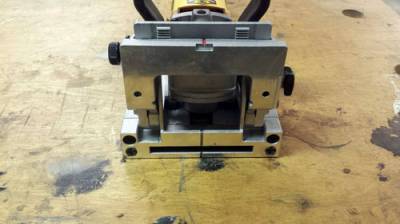
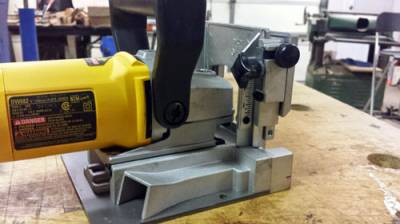
The 557 went a different route. It utilizes a knob on top of the fence to adjust the cutter height and it's locked into place with a separate knob on the left of the fence. I give a slight advantage to the 557 here because the height adjustment is smoother and a touch easier to dial in. While this system is in fact slower to adjust than the 682K, I don't see that it is a hindrance. I'd prefer a tool that takes adjustments very smoothly instead of trading off for a bit more speed.
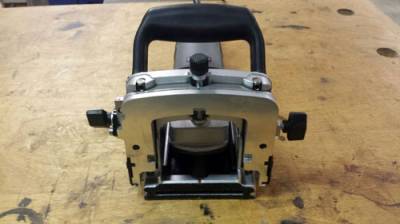
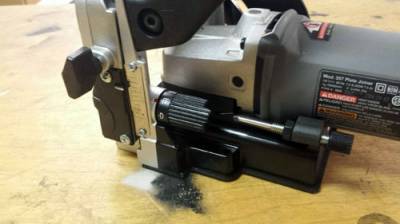
Each of these biscuit joiners has a drop down fence to facilitate biscuiting the edge of a panel or miter. Both units have adjustable angle gauges that are easily read. The 682K and 557 fences are straight forward to use and lock into place with a single knob. However, the 557 fence can travel to 135° with a solid stop at 90°, as opposed to the 682K, which can only adjust to 90°. Don't let this fool you though, DeWalt had something up their sleeves. Even though the 682K won't adjust all the way to 135°, it will still cut on this angle, thanks to a little notch cut out of the bottom of its fence. I was really impressed by the attention to detail here.
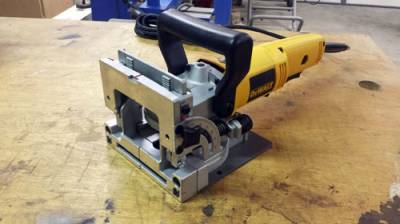
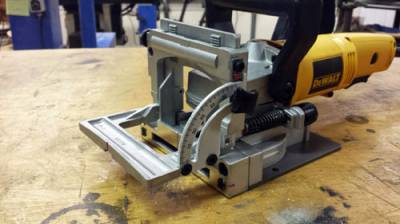
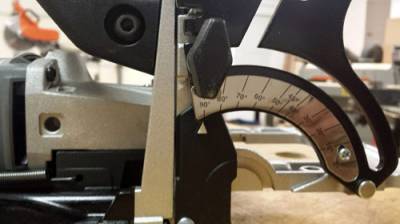
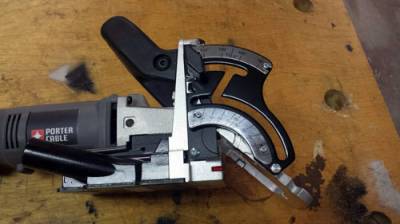
The alignment markings on each tool are fairly easy to read. However, the 682K has more precise markings for blade alignment that are crisp and detailed while the 557's are a bit more ambiguous and require more attention for proper alignment. The witness marks for blade location on the side of each tool is different from one to the next. The 557's mark shows the full thickness of the blade, while the 682K's mark just shows the centerline. I find that a crisp mark that just shows the centerline is easier to work with than a thick mark where the centerline has to be visually quantified. Each of the tool's fences are easy to read and adjust for accurate setup.
When it comes to user interface, the 557 comes out on top. The knobs are larger and easier to manipulate than those found on the 682K. The depth adjustment knob for different biscuit sizes is much easier to manipulate than the one found on the 682K. The 557 also has a very easy to use micro depth adjustment to perfectly dial in the biscuit slots. In addition to the standard biscuit sizes, the 557 has an extra trick up its sleeve. You can adjust for cutting face frame biscuits on the 557, which are very shallow and use a 2" blade. There is no such setting on the 682K.
Dust Collection:
The dust collection award goes to the 682K. It has two adapters that allow the use of the bag or a vacuum hose, which both work very well. The only complaint is that the 682K adapters are crazy tough to remove from the plate joiner. The 557 has a huge dust bag that seems oversized for the job at hand and does not stay on the adapter very well. You can also supposedly hook the 557 up to a vacuum hose. My non-static hose from Woodcraft did not fit the 557's 1" OD dust port, but did interface with the 682K quite well.
In Use:
I ran each plate joiner through the same series of tasks during this review. There are small differences in the use of these tools, but overall I was quite happy with the performance and results.
Edge Biscuiting:
Each plate joiner performed this task well. Edge biscuiting with either the fence set to 90° or using the bottom surface of the tool against the workbench yielded great results. The only real difference worth noting is how the handle is located on the tool. On the 682K, the handle is on the body of the tool itself, which means that both the left and right hands are pushing the tool into the work. The 557's handle is located on the fence assembly. This means that the left hand stabilizes the fence against the work and the right hand advances the cutter. I find the 557 a touch more user friendly in this regard.
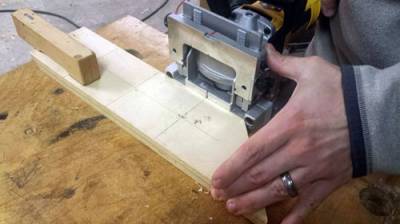
When it comes to making an edge biscuit that's twice as thick, the 557 has a superior advantage over the 682K. With the fence set to 90°, slide the supplied acrylic plate into place on the fence and cut your second slot. This decreases the distance from the top of the board to the cutter by the thickness of one biscuit and allows you to make biscuit joints that are extra strong with minimal effort. If you wanted to add an extra wide slot with the 682K, you'd have to adjust the height of the fence each time.
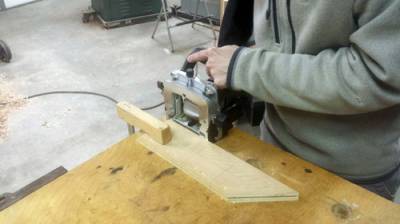
Winner: 557
Face Biscuiting:
Each plate joiner is certain to move a bit when making this cut once the unit is turned on. The only way to mitigate this is to set up an auxiliary fence to rest the bottom of the plate joiner on. When it comes to the alignment of the cutter, each tool has witness marks for quick alignment. The 557 only has a single mark on the centerline for alignling this cut.
Conversely, the 682K has two additional marks at the widest portion of the blade. For me, these extra marks don't add much to the usability of the tool, but it's nice to visually see the OD of the cutter just for a little peace of mind.
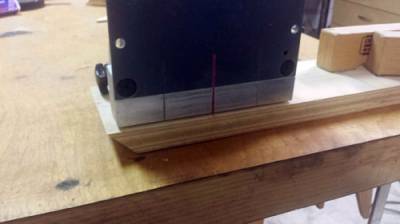
Winner: 682K
Cutting on a 45° Face:
A slight edge goes to the 557 on this operation. I like that the face of the tool (which contacts the work) is covered with abrasive tape similar to deck tape used on skateboards. This gives grip along the entire face of the tool.
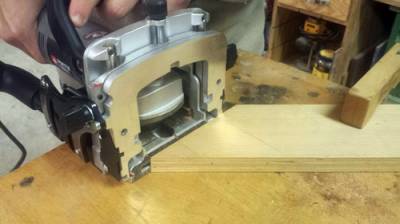
As you can see, only one of the two spurs on the 682K contact the work piece during this cut. I personally didn't have much trouble using either tool in this operation, but the 682K did slide when initially starting the joiner.
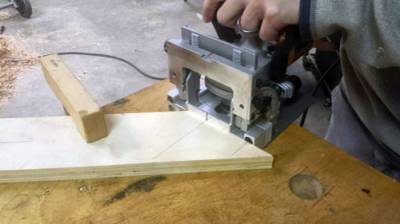
Winner: 557
Cutting on a 135°Edge:
Both plate joiners can perform this task, but the 557 has a leg up since its fence will adjust to 135°. This provides the full support of the fence and gives a very secure feel to the tool while cutting.
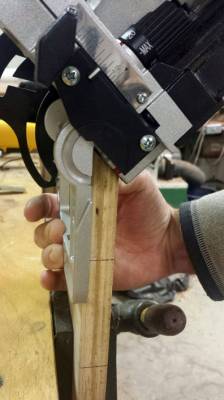
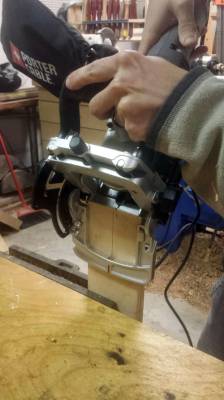
As previously mentioned, the 682K has small section cut at a 45° on the bottom of its fence, which facilitates cutting on a 135° edge. This is plenty accurate, but doesn't give the same amount of assurance as the 557's fully adjustable fence.
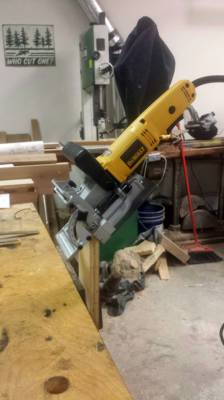
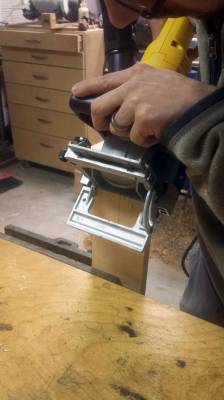
Winner: 557
Final Thoughts:
These two tools are among the most popular plate joiners on the market today for good reason. They are both solid tools that work smoothly without bogging down in the cut. The Porter Cable 557 comes out above the DeWalt 682K for the extra adjustment in the fence, better grip on cutting face, acrylic plate for double thick biscuit joints, and the face frame setting. I also like the ergonomics of the 557 better than the 682K.
These plate joiners are available at a variety of locations. In the US, the 557 retails around $225 and the 682K is about $200.
Full Disclosure: These tools were provided free of charge for an unbiased review. Rest assured, If I wouldn't buy or use this product in my shop I'd tell you.
I hope this review helps you decide which of these two great tools is right for you. If you have any questions, please don't hesitate to ask! Until next time, be safe, and happy woodworking!











